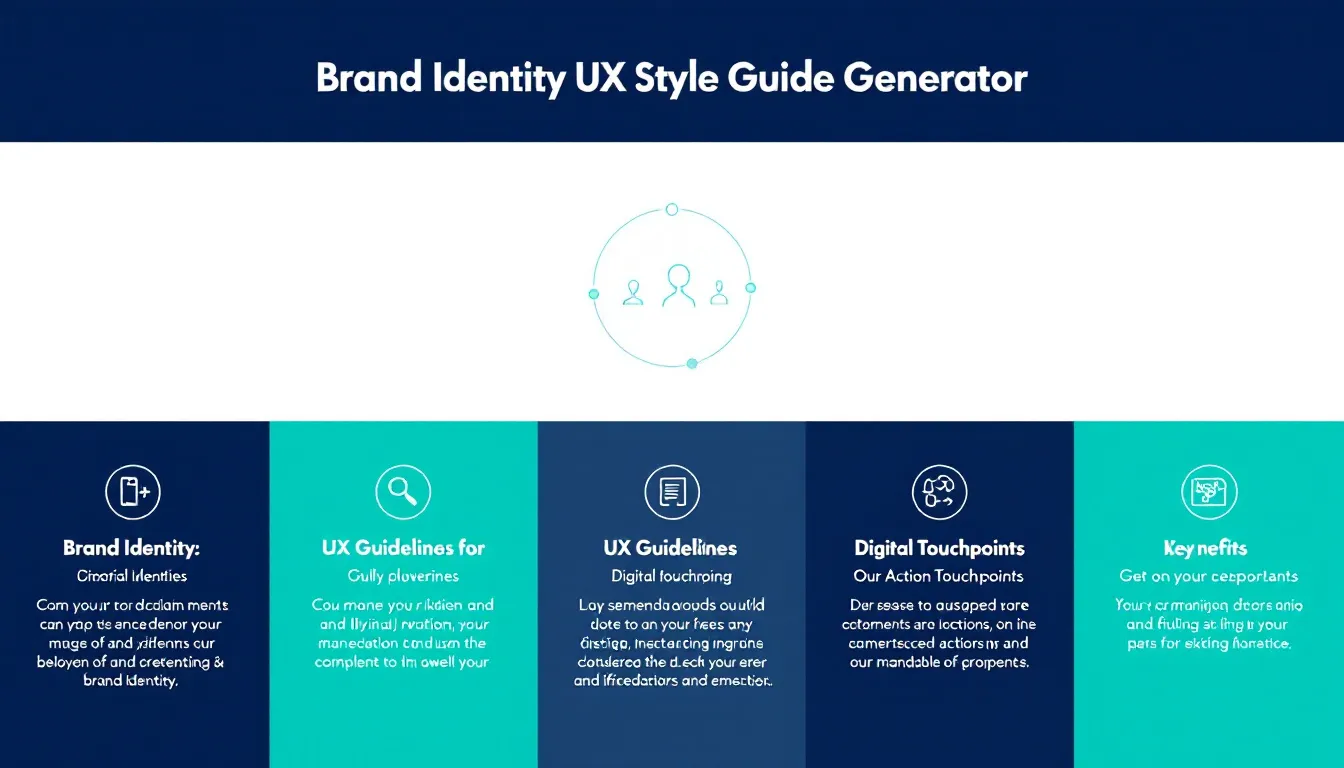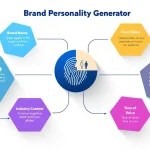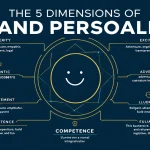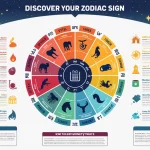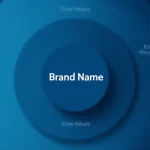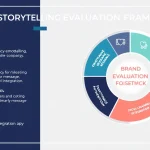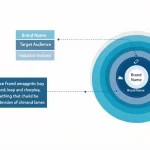Is this tool helpful?
How to Use the Brand Identity UX Style Guide Generator Effectively
Follow these steps to generate a detailed, user-centered brand identity style guide that fits your digital presence and audience needs:
- Brand Name: Enter the official name of your brand. For example, use “Urban Bloom” for a modern flower delivery service or “BrightWave” for a tech startup focusing on renewable energy.
- Target Audience: Describe your customer base with clear traits. For instance, “Young families in suburban areas, eco-conscious and budget-minded” or “Freelancers and remote workers, aged 22-40, valuing flexibility and productivity tools.”
- Brand Values: List the key principles and characteristics your brand stands for. Examples include “Community-driven, reliability, transparency” or “Innovation, accessibility, customer-first approach.”
- User Challenges: Specify the main problems users face when engaging with your brand online. Examples: “Slow page load times during checkout,” or “Difficulty finding product information.”
- Digital Touchpoints: Optionally, list the platforms where your brand interacts with users, such as “Email newsletters, online marketplace, mobile chat support.”
Understanding the Brand Identity UX Style Guide Generator
The Brand Identity UX Style Guide Generator helps you craft a consistent, user-focused style guide for your digital brand presence. It merges brand identity factors with user experience design principles to produce clear guidelines that ensure coherence and enhance user engagement across your platforms.
Purpose and Benefits
- Establish Brand Consistency: Maintain uniform visuals and messaging across websites, apps, social media, and other digital channels.
- Enhance User Experience: Address user pain points and behaviors to shape intuitive and accessible interactions.
- Streamline Style Guide Creation: Save time by automating the process of compiling design standards and UX guidelines.
- Align Business and User Needs: Create guidelines that reflect both your brand’s vision and your audience’s expectations.
Core Features of the Generator
- Integration of brand identity elements like logos, colors, and tone
- User-centered design guidelines that focus on accessibility and usability
- Specification of digital touchpoints to tailor style guidelines per platform
- Clear interaction patterns for navigation and content layout
- Framework for consistent brand messaging and personality
Practical Applications of the Brand Identity UX Style Guide Generator
Example 1: Nonprofit Organization
A nonprofit called “GreenStep Initiative” uses the generator to:
- Define a compassionate and trustworthy tone of voice
- Ensure accessibility for diverse user groups on their website
- Standardize email campaigns and social media posts
- Improve user navigation for donation and volunteer sign-up pages
Example 2: Online Education Platform
An e-learning company, “LearnSphere,” applies the tool to:
- Create unified branding across mobile app and web portal
- Develop interaction standards for course navigation and quizzes
- Maintain consistency in tutorial videos and support documentation
- Highlight brand values centered on inclusivity and innovation
Problem Solving with the Style Guide Generator
Resolving Brand Inconsistencies
The tool addresses common issues that disrupt brand coherence by:
- Standardizing fonts, colors, and iconography
- Aligning messaging tone across team and platforms
- Defining user interface conventions to reduce confusion
Improving User Experience
It enhances digital interactions by providing guidelines on:
- Accessibility standards to include users with disabilities
- Navigation best practices for easy content discovery
- Content structure that clarifies priority and flow
Implementation Strategies for Brand UX Style Guides
Phase 1: Brand Research and Setup
- Document your brand’s existing identity elements
- Incorporate user research insights and personas
- Map key digital touchpoints used by your audience
Phase 2: Develop Guidelines
- Establish visual design standards including color usage and typography
- Define interaction and navigation patterns
- Create content tone and messaging frameworks aligned to your values
Phase 3: Team Training and Quality Assurance
- Conduct workshops to ensure team understanding and adoption
- Set quality control processes to maintain guideline adherence
- Regularly monitor and update guidelines based on feedback and trends
Frequently Asked Questions About the Brand Identity UX Style Guide Generator
How often should I update my style guide?
Review and update your style guide every 6 to 12 months. Also, update it promptly when introducing significant brand changes or launching new digital platforms.
Can I tailor the style guide for different platforms?
Yes, you can customize guidelines per platform, such as mobile apps or websites, while keeping a consistent overall brand identity.
How do I encourage team adoption of the style guide?
Provide ongoing training, make documentation easy to access, and establish clear channels for support and feedback.
What role does user feedback play in building the style guide?
User feedback helps refine your guidelines to better meet your audience’s needs and improve usability.
How detailed should the target audience description be?
Include specific demographics, behavioral traits, preferences, and pain points to create focused, effective style guidelines.
Can I integrate existing brand documents into the generator?
Yes, this tool complements your current brand guidelines by adding user experience best practices and digital design standards.
Best Practices for Creating Impactful Brand Identity UX Style Guides
1. Schedule Regular Updates
- Plan periodic reviews to keep the guidelines current
- Incorporate ongoing user feedback
- Stay aware of emerging digital trends and technologies
2. Foster Team Collaboration
- Engage stakeholders across departments like design, marketing, and development
- Encourage diverse viewpoints
- Maintain open communication for questions and suggestions
3. Maintain Clear Documentation
- Create detailed and accessible style guide resources
- Keep records organized with version control
- Ensure materials are easy for all team members to find and use
Key Components of the Brand Identity UX Style Guide
Visual Elements
- Color palettes with usage rules
- Typography including font choices and hierarchy
- Imagery styles such as photography and iconography
- Logo variations and guidelines
Interaction Patterns
- Navigation structures for websites and apps
- Button styles and hover effects
- Form designs and validation behavior
- User feedback mechanisms like notifications and alerts
Content Guidelines
- Tone of voice aligned with brand personality
- Writing style and grammar preferences
- Content hierarchy to organize information effectively
- Messaging frameworks that maintain clear and consistent communication
Important Disclaimer
The calculations, results, and content provided by our tools are not guaranteed to be accurate, complete, or reliable. Users are responsible for verifying and interpreting the results. Our content and tools may contain errors, biases, or inconsistencies. Do not enter personal data, sensitive information, or personally identifiable information in our web forms or tools. Such data entry violates our terms of service and may result in unauthorized disclosure to third parties. We reserve the right to save inputs and outputs from our tools for the purposes of error debugging, bias identification, and performance improvement. External companies providing AI models used in our tools may also save and process data in accordance with their own policies. By using our tools, you consent to this data collection and processing. We reserve the right to limit the usage of our tools based on current usability factors.
